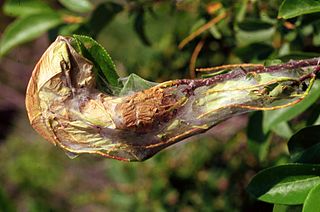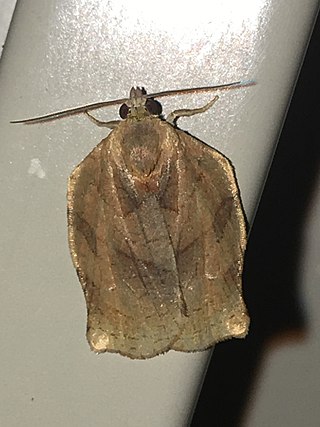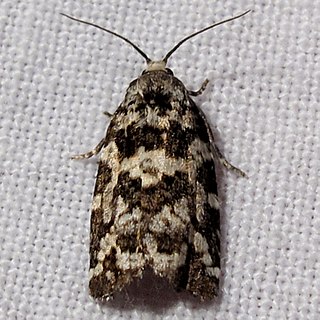
The Tortricidae are a family of moths, commonly known as tortrix moths or leafroller moths, in the order Lepidoptera. This large family has over 11,000 species described, and is the sole member of the superfamily Tortricoidea, although the genus Heliocosma is sometimes placed within this superfamily. Many of these are economically important pests. Olethreutidae is a junior synonym. The typical resting posture is with the wings folded back, producing a rather rounded profile.

Archips rosana, the rose tortrix, is a moth of the family Tortricidae. It is found in both the Palearctic and Nearctic realms.

Archips is a genus of tortrix moths the tribe Archipini. Species include the oak leaf roller, which eats the leaves of oak trees.

Archips crataegana, the brown oak tortrix, is a moth of the family Tortricidae. It is found in most of Europe east to Japan.

Archips cerasivorana, the ugly-nest caterpillar moth, is a species of moth of the family Tortricidae. The caterpillars of this species are known to create nests by tying the leaves of their host plant together. Within the nests, they live and feed off the leaves that have been tied together. The larvae are brownish or greenish yellow with a shiny dark brown head. Larvae can be found from May to July. The species overwinters as an egg, and pupation takes place within the nest. Caterpillars are seen to follow one another in trails, a behavior prompted by the release of signaling pheromones from their spinnerets.
Archips alberta is a species of moth of the family Tortricidae first described by James Halliday McDunnough in 1923. It is found in North America, where it has been recorded across boreal Canada, south through the mountains to Utah. The habitat consists of coniferous forests.
Archips asiaticus, the groundnut leafroller, is a species of moth of the family Tortricidae. It is found in Russia (Siberia), Korea, Japan and China.
Archips fuscocupreanus, the exotic leafroller moth or apple tortrix, is a species of moth of the family Tortricidae. It is found in China, South Korea, Japan and Russia. It is an introduced species in the north-eastern United States, where it has been recorded from Connecticut, Massachusetts, New Jersey, New York and Rhode Island. It has also been recorded from Washington.

Archips strianus, the striated tortrix moth or striated leafroller, is a species of moth of the family Tortricidae. It is found in North America, where it has been recorded from Alberta, British Columbia, Maine, Michigan, Minnesota, Montana, New Brunswick, Newfoundland, Ontario and Quebec.

Archips georgianus, the Georgia archips moth, is a species of moth of the family Tortricidae. It is found in North America, where it has been recorded from New Jersey, south to Florida and then west to Texas.
Archips nigriplaganus is a species of moth of the family Tortricidae. It is found in North America, where it has been recorded from Kentucky, North Carolina, Quebec, Tennessee, Vermont and West Virginia.

Archips mortuanus, the dusky-back leaf roller, is a species of moth of the family Tortricidae. It is found in eastern North America, where it has been recorded from Maine, Michigan and New York.

Archips purpuranus, the omnivorous leafroller moth, is a species of moth of the family Tortricidae. It is found in most of eastern North America.
Archips eleagnanus is a species of moth of the family Tortricidae first described by James Halliday McDunnough in 1923. It is found in North America, where it has been recorded from Alberta, Manitoba, Saskatchewan, Wyoming and New Mexico. The habitat consists of prairies and montane areas.
Archips myricanus is a species of moth of the family Tortricidae. It is found in North America, where it has been recorded from Maine, Montana and Ontario.
Archips magnolianus is a species of moth of the family Tortricidae. It is found in the United States, where it has been recorded from Alabama, Georgia, Kentucky, Louisiana, Maryland, Mississippi, New York, North Carolina, Ohio, Pennsylvania, South Carolina, Tennessee and West Virginia.
Archips infumatanus, the smoked leafroller moth or hickory webworm, is a species of moth of the family Tortricidae. It is found in North America, where it has been recorded from Quebec and Ontario south to Florida and west to Texas and Iowa.
Archips rileyanus, the southern ugly-nest caterpillar moth, is a species of moth of the family Tortricidae. It is found in North America, where it has been recorded from Alabama, Florida, Georgia, Maine, Mississippi, Missouri, North Carolina, Ohio, Tennessee, Texas, Virginia and West Virginia.
Archips dissitanus, the boldly-marked archips moth, is a species of moth of the family Tortricidae. It is found in North America, where it has been recorded from Alberta to Nova Scotia and south to Minnesota and North Carolina in the Appalachian Mountains. The habitat consists of boreal forests.

Archips packardianus, the spring spruce needle moth or spruce needleworm, is a species of moth of the family Tortricidae. Spruce needle worms are commonly found in small numbers on spruce and trees of other coniferous genera throughout most of Canada and the northeastern US. Archips packardiana overwinters as a tiny larva in a mined needle. Needle mining is resumed in the spring, the larvae later moving to feed on new foliage, where they spin considerable webbing. Full-grown larvae have a pale green head, sometimes patterned with brown, and a pale body and pale thoracic legs, and are about 20 mm long. The larva pupates, usually in the webbed needles, and the adult emerges in summer to early fall. The closely related Archips strianus is much less common, but probably has a habitat similar to that of A. packardiana. The larvae have dark thoracic legs and small dark areas around the base of the thoracic hairs. The habitat consists of coniferous and mixed woods.









